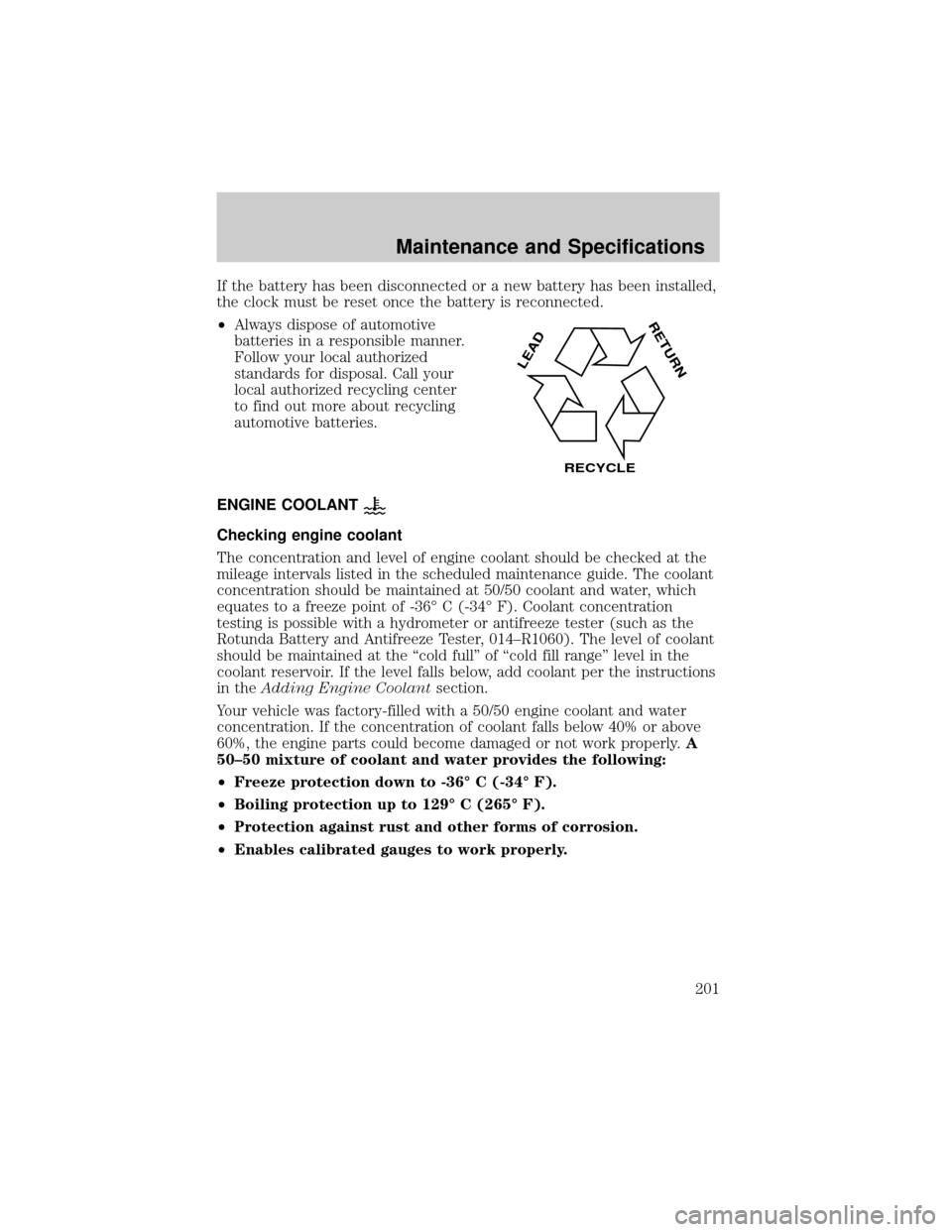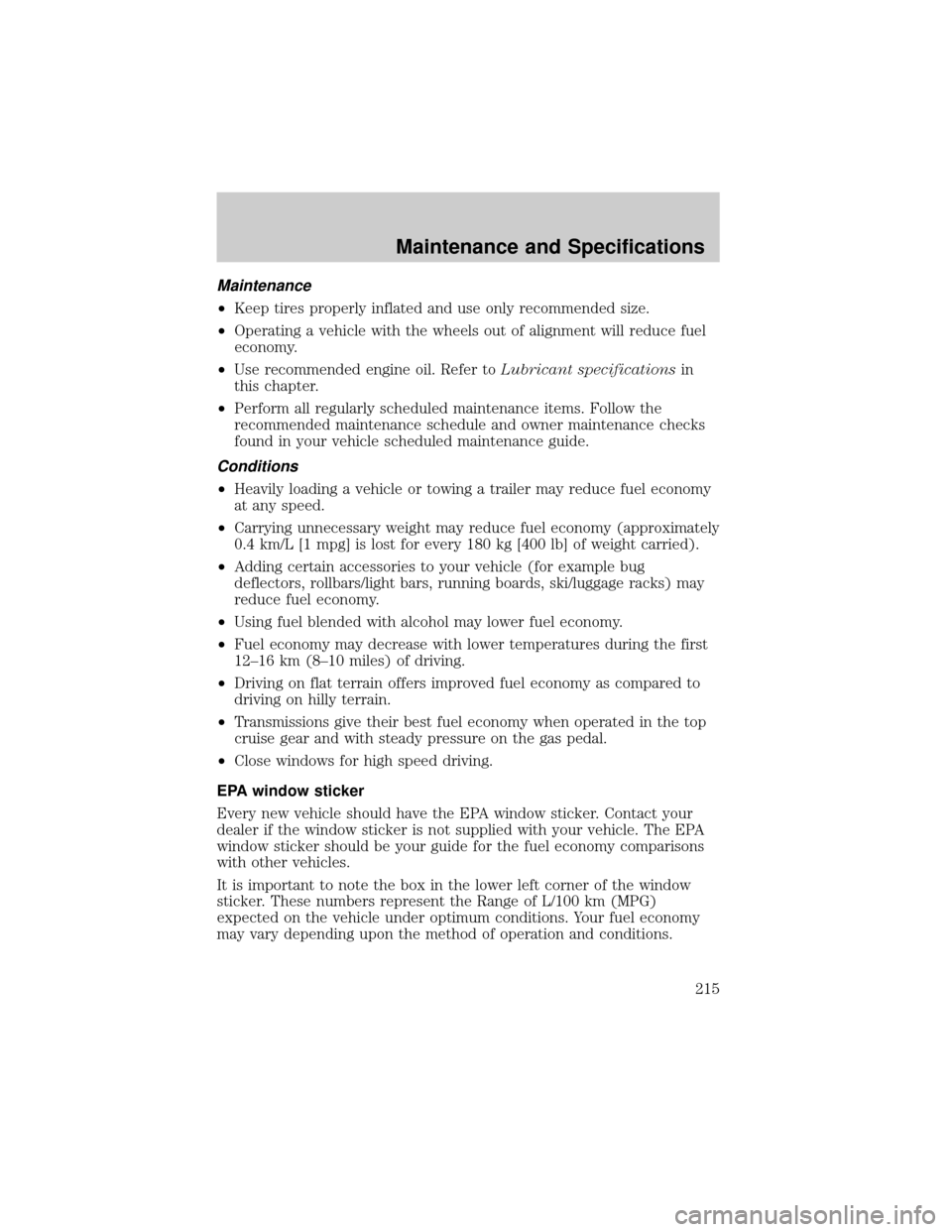2002 LINCOLN TOWN CAR oil
[x] Cancel search: oilPage 201 of 248

If the battery has been disconnected or a new battery has been installed,
the clock must be reset once the battery is reconnected.
²Always dispose of automotive
batteries in a responsible manner.
Follow your local authorized
standards for disposal. Call your
local authorized recycling center
to find out more about recycling
automotive batteries.
ENGINE COOLANT
Checking engine coolant
The concentration and level of engine coolant should be checked at the
mileage intervals listed in the scheduled maintenance guide. The coolant
concentration should be maintained at 50/50 coolant and water, which
equates to a freeze point of -36É C (-34É F). Coolant concentration
testing is possible with a hydrometer or antifreeze tester (such as the
Rotunda Battery and Antifreeze Tester, 014±R1060). The level of coolant
should be maintained at the ªcold fullº of ªcold fill rangeº level in the
coolant reservoir. If the level falls below, add coolant per the instructions
in theAdding Engine Coolantsection.
Your vehicle was factory-filled with a 50/50 engine coolant and water
concentration. If the concentration of coolant falls below 40% or above
60%, the engine parts could become damaged or not work properly.A
50±50 mixture of coolant and water provides the following:
²Freeze protection down to -36É C (-34É F).
²Boiling protection up to 129É C (265É F).
²Protection against rust and other forms of corrosion.
²Enables calibrated gauges to work properly.
LEAD
RETURN
RECYCLE
Maintenance and Specifications
201
Page 215 of 248

Maintenance
²Keep tires properly inflated and use only recommended size.
²Operating a vehicle with the wheels out of alignment will reduce fuel
economy.
²Use recommended engine oil. Refer toLubricant specificationsin
this chapter.
²Perform all regularly scheduled maintenance items. Follow the
recommended maintenance schedule and owner maintenance checks
found in your vehicle scheduled maintenance guide.
Conditions
²Heavily loading a vehicle or towing a trailer may reduce fuel economy
at any speed.
²Carrying unnecessary weight may reduce fuel economy (approximately
0.4 km/L [1 mpg] is lost for every 180 kg [400 lb] of weight carried).
²Adding certain accessories to your vehicle (for example bug
deflectors, rollbars/light bars, running boards, ski/luggage racks) may
reduce fuel economy.
²Using fuel blended with alcohol may lower fuel economy.
²Fuel economy may decrease with lower temperatures during the first
12±16 km (8±10 miles) of driving.
²Driving on flat terrain offers improved fuel economy as compared to
driving on hilly terrain.
²Transmissions give their best fuel economy when operated in the top
cruise gear and with steady pressure on the gas pedal.
²Close windows for high speed driving.
EPA window sticker
Every new vehicle should have the EPA window sticker. Contact your
dealer if the window sticker is not supplied with your vehicle. The EPA
window sticker should be your guide for the fuel economy comparisons
with other vehicles.
It is important to note the box in the lower left corner of the window
sticker. These numbers represent the Range of L/100 km (MPG)
expected on the vehicle under optimum conditions. Your fuel economy
may vary depending upon the method of operation and conditions.
Maintenance and Specifications
215
Page 226 of 248

Follow these guidelines when using snow tires and chains:
²Use only cable type chains offered by Ford as an accessory or
equivalent. Using SAE class S or other conventional link type chains
may cause damage to the vehicle's wheel house and/or body.
²Install chains securely, verifying that the chains do not touch any
wiring, brake lines or fuel lines.
²Drive cautiously. If you hear the chains rub or bang against your
vehicle, stop and re-tighten the chains. If this does not work, remove
the chains to prevent damage to your vehicle.
²If possible, avoid fully loading your vehicle.
²Remove the tire chains when they are no longer needed. Do not use
tire chains on dry roads.
²The suspension insulation and bumpers will help prevent vehicle
damage. Do not remove these components from your vehicle when
using snow tires and chains.
MOTORCRAFT PART NUMBERS
Component 4.6L SOHC V8 engine
Air filter element FA-1668
Fuel filter FG-986B
Battery-standard BXT-65-650
Battery-heavy duty
1BXT-65-750
Oil filter FL-820-S
PCV valve EV-98
Spark plugs
2AWSF-32P
1Included in long wheelbase package.
2Refer to Vehicle Emissions Control Information (VECI) decal for spark
plug gap information.
Maintenance and Specifications
226
Page 227 of 248

REFILL CAPACITIES
Fluid Ford Part Name Capacity
Engine oil (includes
filter change)Motorcraft SAE 5W-20
Super Premium Motor
Oil4.7L (5.0 quarts)
Brake fluid Motorcraft High
Performance DOT 3
Motor Vehicle Brake
Fluid
1
Fill to line on reservoir
Power steering fluid Motorcraft MERCONt
AT FFill to line on reservoir
Transmission fluid
2Motorcraft
MERCONtVATF13.2L (13.9 quarts)3
Engine coolant4Motorcraft Premium
Engine Coolant
(green-colored)or
Motorcraft Premium
Gold Engine Coolant
(yellow-colored)15.0L (15.8 quarts)
Fuel tank N/A 71.9L (19.0 gallons)
Rear axle lubricant
5Motorcraft SAE
80W-90 Premium Rear
Axle Lubricant1.8L (3.75 pints)6
Windshield washer
fluidUltra-Clear Windshield
Washer ConcentrateFill to line on reservoir
1Use only brake fluids certified to meet Ford specifications. Refer to
Lubricant Specificationsin this chapter. DOT 3 fluid is recommended.
However, if DOT 3 is not available, DOT 4 fluid can be used.
2Ensure the correct automatic transmission fluid is used. MERCONtand
MERCONtV are not interchangeable. DO NOT MIX MERCONtand
MERCONtV. Refer to the scheduled maintenance guide to determine
the correct service interval.
3Indicates only approximate dry-fill capacity. Some applications may vary
based on cooler size and if equipped with an in-tank cooler. The amount
of transmission fluid and fluid level should be set by the indication on
the dipstick's normal operating range.
Maintenance and Specifications
227
Page 228 of 248

4Add the coolant type originally equipped in your vehicle.
5Rear axles are considered lubricated for life when the vehicle is used for
normal service. See your scheduled maintenance guide for Severe Duty
requirements.
6Add 118 ml (4 oz.) of Additive Friction Modifier C8AZ-19B546-A or
equivalent meeting Ford specification EST-M2C118±A for complete refill
of Traction-Lok rear axle.
For limousine, use 2.4L (5.0 pints) of Motorcraft SAE 75W-140 Synthetic
Rear Axle Lubricant or equivalent meeting Ford specification
WSL-M2C192-A for complete refill of rear axle.
Service refill capacities are determined by filling the rear axle 6 mm to
14 mm (1/4 inch to 9/16 inch) below the bottom of the filler hole.
LUBRICANT SPECIFICATIONS
Item Ford part
nameFord part
numberFord
specification
Brake fluid Motorcraft High
Performance
DOT 3 Motor
Vehicle Brake
Fluid
1
PM-1 ESA-M6C25-A
and DOT 3
Door
weatherstripsSilicone
LubricantF7AZ-19G208-BA
and
F5AZ-19553-AAESR-M13P4-A
Engine coolant Motorcraft
Premium Engine
Coolant (green
colored)VC-4±A (US) or
CXC-10
(Canada)ESE-M97B44-A
Motorcraft
Premium Gold
Engine Coolant
(yellow colored)VC-7±A WSS-M97B
51-A1
Engine oil Motorcraft SAE
5W20 Super
Premium Motor
OilXO-5W20-QSP WSS-M2C153-H
with API
Certification
Mark
Maintenance and Specifications
228
Page 230 of 248

ENGINE DATA
Engine 4.6L SOHC V8 engine
Cubic inches 281
Required fuel 87 octane
Firing order 1-3-7-2-6-5-4-8
Spark plug gap 1.3-1.4 mm (0.052-0.056 inch)
Ignition system Coil on plug
Compression ratio 9.4:1
VEHICLE DIMENSIONS
Vehicle dimensions mm (in)
(1) Overall length 5 469 (215.3)/5 621 (221.3)a
(2) Overall width 1 987 (78.2)
(3) Overall height 1 472 (58.0)
(4) Wheelbase 2 990 (117.7)/3 142 (123.7)
a
(5) Track - Front 1 611 (63.4)
(5) Track - Rear 1 659 (65.3)
aDenotes long wheel base
2
5
3
Maintenance and Specifications
230
Page 238 of 248

in front seat ............................131
in rear seat ..............................131
Cleaning your vehicle
engine compartment ..............187
exterior ....................................191
instrument cluster lens ..........190
instrument panel ....................190
interior .....................................190
plastic parts ............................189
safety belts ..............................191
washing ....................................186
waxing .....................................186
wheels ......................................187
windows ..................................191
wiper blades ............................189
Clock ................................22, 32, 61
Compass, electronic ....................63
calibration .................................79
set zone adjustment ...........78±79
Console
rear ............................................85
Controls
power seat ...............................103
steering column ........................68
Coolant
checking and adding ..............201
coolant temperature light ........13
refill capacities ................205, 227
specifications ..................228, 230
Cruise control (see Speed
control) ........................................65
Customer Assistance ................156
Ford accessories for your
vehicle .............................192, 234
Ford Extended Service
Plan ..........................................178
Getting assistance outside the
U.S. and Canada .....................182
Getting roadside assistance ...156Getting the service you
need .........................................176
Ordering additional owner's
literature .................................183
The Dispute Settlement
Board .......................................179
Utilizing the
Mediation/Arbitration
Program ...................................182
D
Daytime running lamps (see
Lamps) .........................................49
Defrost
rear window ..............................48
Dipstick
automatic transmission
fluid ..........................................219
engine oil .................................195
Doors
door ajar warning .....................15
lubricant specifications ..........228
Driving under special
conditions
through water .........................149
E
Emergencies, roadside
jump-starting ..........................169
Emission control system ..........216
Engine ........................................230
check engine/service engine
soon light ..................................10
cleaning ...................................187
coolant .....................................201
fail-safe coolant ......................206
idle speed control ...................199
Index
238
Page 239 of 248

lubrication
specifications ..................228, 230
refill capacities ........................227
service points ..........................194
starting after a collision .........157
Engine block heater .................139
Engine oil ..................................195
change oil soon warning,
message center .......................195
checking and adding ..............195
dipstick ....................................195
filter, specifications ........198, 226
recommendations ...................198
refill capacities ........................227
specifications ..................228, 230
Exhaust fumes ..........................139
F
Fail safe cooling ........................206
Floor mats ...................................87
Fluid capacities .........................227
Fuel ............................................207
calculating fuel
economy ............................80, 212
cap .....................................11, 209
capacity ...................................227
choosing the right fuel ...........210
comparisons with EPA fuel
economy estimates .................215
detergent in fuel .....................212
filling your vehicle with
fuel ...........................207, 209, 212
filter, specifications ........212, 226
fuel filler door override ............84
fuel filler door release ..............84
fuel pump shut-off switch .....157
gauge .........................................18
improving fuel economy ........212octane rating ...................211, 230
quality ......................................211
running out of fuel .................212
safety information relating to
automotive fuels .....................207
Fuses ..................................158±159
G
Garage door opener ....................69
Gas cap (see Fuel cap) ......11, 209
Gas mileage (see Fuel
economy) ...................................212
Gauges .........................................17
engine coolant temperature
gauge .........................................17
fuel gauge ..................................18
odometer ...................................18
speedometer .............................18
GAWR (Gross Axle Weight
Rating) .......................................150
definition .................................150
driving with a heavy load ......150
location ....................................150
GVWR (Gross Vehicle Weight
Rating) .......................................150
calculating ...............................150
definition .................................150
driving with a heavy load ......150
location ....................................150
H
Hazard flashers .........................157
Head restraints .........................102
Headlamps ...................................49
aiming ..................................51±52
autolamp system .......................49
Index
239